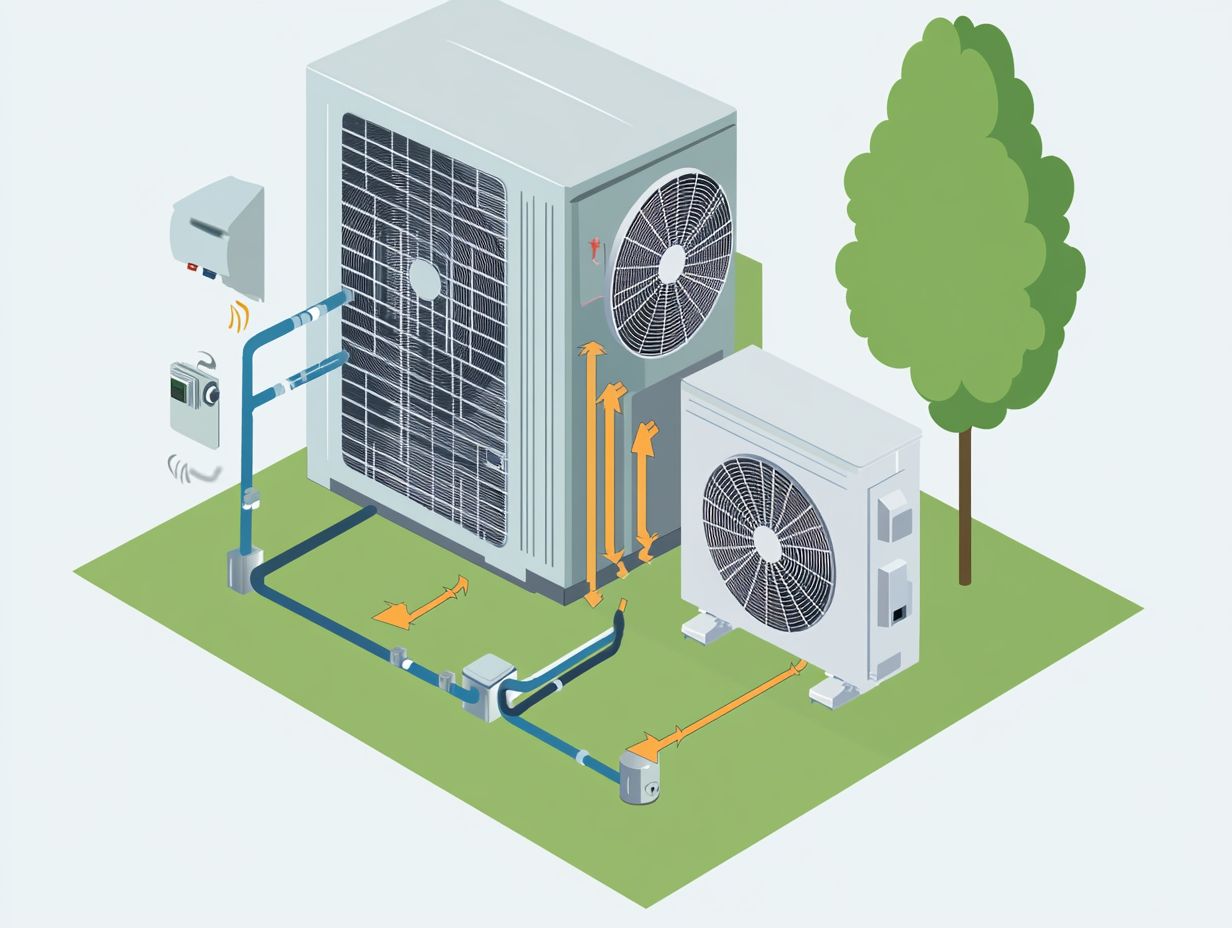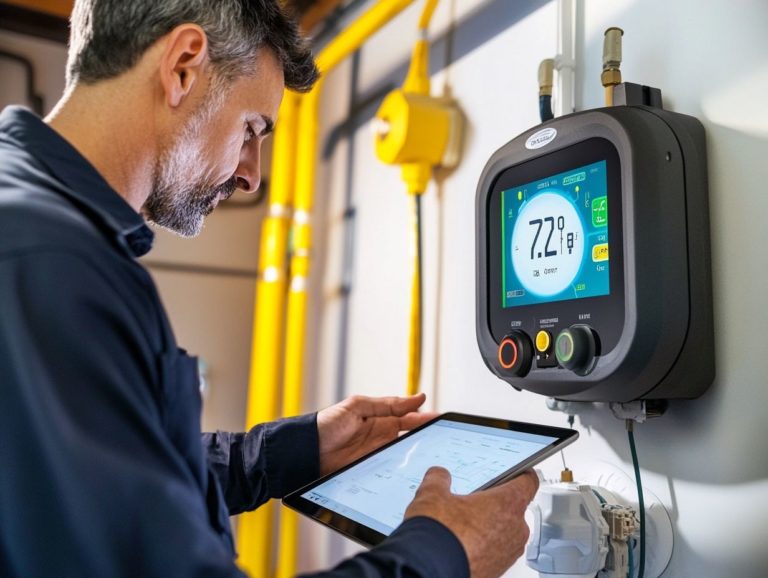How Does a Heat Pump Work?
Today, energy efficiency and eco-friendly solutions are vital. Heat pumps are becoming a popular choice for heating and cooling homes.
But what exactly is a heat pump, and how does it work? This article will provide you with the essentials, exploring the different types of heat pumps, their key components, and the mechanics behind their efficient heat transfer.
You ll discover the benefits and drawbacks of using a heat pump compared to traditional systems. Join us as we delve into the versatile world of heat pumps, helping you decide if they re the perfect fit for your home.
Contents
- Key Takeaways:
- Basic Functioning of a Heat Pump
- Types of Heat Pumps
- Components of a Heat Pump
- How Does a Heat Pump Heat and Cool?
- Benefits and Drawbacks of Using a Heat Pump
- Frequently Asked Questions
- What is a heat pump and how does it work?
- How does a heat pump extract heat from the environment?
- Can a heat pump provide both heating and cooling?
- What are the advantages of using a heat pump?
- How does a heat pump compare to traditional heating systems?
- Are there different types of heat pumps?
- Conclusion
Key Takeaways:

- Heat pumps are energy-efficient heating and cooling systems that use heat transfer to regulate temperature in a space.
- There are three types of heat pumps: air source, ground source, and water source, each using different mediums to transfer heat.
- A heat pump operates by reversing the flow of refrigerant, a special fluid that allows it to both heat and cool a space, making it a versatile and cost-effective option.
What is a Heat Pump?
A heat pump is an advanced HVAC system designed to transfer thermal energy from one location to another, providing both heating and cooling solutions for your residential or commercial space. By using the science of heat and energy movement, heat pumps efficiently regulate indoor temperatures while significantly reducing energy consumption compared to conventional methods.
Traditional furnaces burn fuel or consume a lot of electricity to create heat. In contrast, heat pumps use refrigerants to absorb and release heat. In winter, a heat pump pulls warmth from the outdoor air or ground and delivers it indoors. In summer, the process reverses, expelling heat from inside to the outside.
This dual functionality ensures your year-round comfort and leads to substantial energy savings. As homeowners increasingly seek eco-friendly solutions for temperature regulation, a heat pump emerges as a sustainable alternative worth considering, particularly as part of a renewable energy strategy.
Basic Functioning of a Heat Pump
The fundamental operation of a heat pump hinges on a thermodynamic process involving a refrigerant circulating through key components: the compressor, condenser, and evaporator. This ensures efficient heat transfer.
This sophisticated system absorbs and releases thermal energy, enabling precise temperature regulation tailored to your needs, enhancing indoor air quality.
Heat Transfer and Energy Efficiency
Heat transfer is a crucial element in the energy efficiency of heat pumps, influencing how effectively thermal energy moves between the indoor and outdoor units during both heating and cooling modes. This optimal transfer minimizes energy consumption and helps keep those utility bills in check.
Understanding the principles of heat transfer improves performance and plays a critical role in reducing your environmental footprint. Proper insulation is essential for maintaining a stable indoor temperature while minimizing heat loss or gain. Energy labels serve as valuable guides, offering insights into the system’s efficiency and enabling you to make informed decisions.
Maintaining the right refrigerant levels is crucial for seamless operation and maximizing the heat pump’s ability to provide consistent comfort. By integrating these elements, you can significantly enhance the overall efficiency of your heat pump, leading to both cost savings and a more sustainable way of living.
Types of Heat Pumps

You ll find several types of heat pumps, such as air-source heat pumps and ground-source heat pumps, each suited for different applications.
- Air-source
- Ground-source
- Water-source
Each type is designed to optimize energy efficiency and performance, tailored to specific environmental conditions and applications, ensuring effective heat distribution.
Air Source, Ground Source, and Water Source Heat Pumps
Air-source heat pumps harness the outdoor air for both heating and cooling. Ground-source heat pumps tap into the earth’s stable temperatures. Water-source heat pumps utilize nearby bodies of water. Each option presents distinct energy savings and efficiency benefits, depending on your specific environment.
You ll find that air-source heat pumps are exceptionally versatile, easily installed, and perfect for residential settings. Ground-source options may require a heftier initial investment due to the excavation involved. However, they can lead to significant long-term savings thanks to their superior energy efficiency.
If your property is near a suitable body of water, water-source heat pumps can be an efficient alternative. Installation might be influenced by environmental regulations.
As energy costs rise and the focus on renewable energy solutions intensifies, considering these systems aligns beautifully with sustainable practices. This can translate into substantial cost savings over time.
Components of a Heat Pump
The key components of a heat pump are the compressor, condenser, evaporator, and expansion valve.
Each of these elements plays a vital role in moving heat efficiently and regulating temperature. They enable precise temperature regulation, which is crucial for energy performance.
Compressor, Condenser, Evaporator, and Expansion Valve
The compressor serves as the heart of your heat pump. It skillfully compresses the refrigerant and elevates its temperature. Meanwhile, the condenser, evaporator, and expansion valve collaborate seamlessly to facilitate the refrigerant’s phase conversions and optimize heat transfer.
As the refrigerant circulates through the system, the compressor s role becomes paramount. It boosts the refrigerant’s pressure and ensures its smooth flow throughout the heat pump. The condenser cools the high-pressure refrigerant gas, allowing it to release heat into the environment before transforming back into a liquid.
The evaporator plays an essential role by absorbing heat from the surroundings. This prompts the refrigerant to vaporize and effectively draws in warmth. The expansion valve then regulates the refrigerant’s flow, reducing its pressure before it re-enters the evaporator, thus completing the cycle.
Collectively, these components create a well-orchestrated system that maximizes efficiency and enhances overall heat pump performance. This significantly influences its capability to heat or cool spaces effectively, thereby reducing electricity usage.
How Does a Heat Pump Heat and Cool?

A heat pump seamlessly transitions between heating and cooling modes thanks to a reversing valve. This clever mechanism alters the direction of the refrigerant flow, allowing for effective temperature regulation throughout your home.
Reversing Valve and Refrigerant Cycle
The reversing valve is an essential component in heat pumps. It facilitates the shift in the refrigerant cycle that determines whether your system operates in heating or cooling mode. This pivotal mechanism plays a significant role in achieving energy efficiency and optimal temperature regulation.
By redirecting the flow of refrigerant, the reversing valve enables your system to absorb heat from the outside air during colder months or release stored heat indoors when temperatures rise. This seamless toggling between functions enhances your indoor comfort and reduces energy consumption.
The efficiency of this device elevates performance and contributes to lower utility bills. This makes it critical for the energy-conscious homeowner’s heating and cooling strategy in today s market.
When the reversing valve is functioning optimally, it helps maintain consistent indoor temperatures, minimizing fluctuations that could disrupt your comfort.
Benefits and Drawbacks of Using a Heat Pump
Heat pumps provide a wealth of advantages, including significant energy savings and lower energy bills. However, it’s essential to be aware of potential drawbacks that might influence their performance and suitability for specific home heating systems.
Pros and Cons Compared to Other Heating and Cooling Systems
When weighing the pros and cons of heat pumps against traditional air conditioners or electric heating, evaluating energy efficiency, operational costs, and overall performance is crucial to find the best fit for your needs, especially regarding energy bills.
Heat pumps shine due to their remarkable ability to transfer heat rather than simply generating it. Imagine the savings on your utility bills over time! If you’re interested in a more hands-on approach, consider exploring how to make a homemade heat pump. However, keep in mind that the installation costs can be higher than those of conventional systems, which might be a concern if you’re on a budget.
Heat pumps work best in moderate climates, but their effectiveness can wane in extremely cold conditions. Therefore, consider your local climate to ensure optimal performance. Traditional systems may offer straightforward operation, but they often fall short in energy savings.
Frequently Asked Questions

What is a heat pump and how does it work?
A heat pump is a type of heating and cooling system that uses electricity to move heat from one place to another. It extracts heat from the air, ground, or water and distributes it throughout a building.
How does a heat pump extract heat from the environment?
A heat pump uses a special fluid called refrigerant to absorb heat from the environment. The refrigerant is compressed, increasing its temperature, and the heat is released into the building through a heat exchanger.
Can a heat pump provide both heating and cooling?
Yes, a heat pump can provide both heating and cooling by reversing its operation. In winter, it extracts heat from outside and brings it inside. In summer, it removes heat from inside and releases it outside.
What are the advantages of using a heat pump?
Using a heat pump offers several advantages, including energy efficiency, cost-effectiveness, and versatility. It provides both heating and cooling and can be utilized in various climates.
How does a heat pump compare to traditional heating systems?
A heat pump is more energy efficient than traditional heating systems, such as furnaces or boilers, as it does not burn fuel to create heat. It also has a longer lifespan and requires less maintenance, making it a cost-effective choice in the long run.
Are there different types of heat pumps?
Yes, there are several types of heat pumps, including air-source, ground-source, and water-source heat pumps. They vary in the source of heat they extract from but all operate similarly to provide heating and cooling.
Conclusion
In summary, heat pumps offer an efficient, cost-effective, and versatile solution for heating and cooling. Don t wait! Explore the benefits of heat pumps today!






